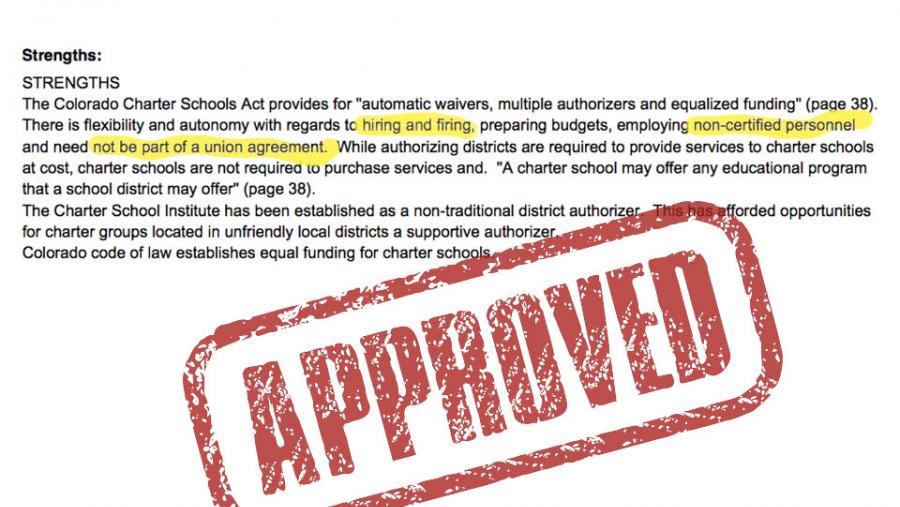Brought To You By Wal-Mart? How the Walton Family Foundation’s Ideological Pursuit is Damaging Charter Schooling - Cashing in on Kids:
There was a sour breeze blowing through the nation’s charter schools in 2014.
Twenty-five years into our nation’s experiment with independently operated, publicly funded charter schools, the news didn’t look good: In May, a new report revealed more than $100 million in fraud, waste and abuse in just 15 of the 43 states that allow charters. (A year later, the report was updated, and the figure rose to $200 million.) Some of the stories defy belief: a school in Philadelphia that was doubling as a nightclub after hours; school operators embezzling millions to pay for high-flying lifestyles; real estate developers cashing in by using public funds to leverage sweet deals on millions of dollars’ worth of property. One after another, the stories emerged. And public officials around the country began to call for change.
In Connecticut, the state Department of Education announced new policies to govern oversight of the state’s charter sector.1 In New York, the charter lobby continued a seven-year fight to prevent the state comptroller from auditing charter schools.2 In Pennsylvania, the auditor general called the charter sector “a mess.”3
How did an idea that promised small-scale innovation as a way to improve the education outcomes of disadvantaged children become a massive industry of more than 6,000 schools, spending upward of $20 billion from taxpayers a year, despite demonstrating no significant academic gains for students?
A significant share of the blame lies at the feet of the Walton Family Foundation (WFF), the Arkansas-based philanthropic arm of the family that brought us Wal-Mart.
When it comes to public education, the Walton Family Foundation is the largest philanthropic donor in the U.S. after the Bill & Melinda Gates Foundation. Gates also supports charter schools, but the Walton Family Foundation ($164 million in education grants in 2013) stands out because of its uncompromisingly ideological approach to public education and its strong support for policy advocacy in line with that approach. And as the tower of cards began to shake, it is the Walton Family Foundation that—more than any other—should take the blame.
This report explores the radical agenda of the Walton family and the foundation it controls, and how that agenda has taken the U.S. charter school movement away from education quality in favor of a strategy focused only on growth. Under the guise of “choice” to improve schools for low-income children, WFF has supported the unregulated growth of a privatized education industry— quantity over quality, and “freedom” over regulation. It’s been lucrative for some, but a disaster for many of the nation’s most vulnerable students and school districts.
THE WAL-MART WAY: INTENSELY IDEOLOGICAL AND MARKET-DRIVEN
“Charters are competitors. They steal customers, deplete revenues and increase costs. When charters siphon off kids, they not only take the money that comes with them, they often cause nearby schools to operate under capacity.” Sam Walton and his brother, Bud, founded Wal-Mart and got rich. Really rich. Sam Walton and his wife Helen’s four children (along with their families) now share in what is estimated to be a collective worth of $150 billion. Of the 10 richest Americans according to Forbes magazine, four are members of the Walton family.
The Walton Family Foundation was established in 1988 and is based in Bentonville, Ark., the home of Wal-Mart.
The late John Walton, who died when the small plane he was piloting crashed in Wyoming in 2005, his widow Christy, and brother, Jim Walton, shared in the leadership of the family foundation. John, more than the others, crafted the foundation’s agenda. Carrie Walton Penner, the daughter of Sam Walton’s eldest son Rob, and her husband, Greg Penner, have also been instrumental in the family’s education work, sitting on the boards of numerous education advocacy and charter organizations and giving generously to the political campaigns of like-minded politicians from their $20 million home in Atherton, Calif. Alice Walton, the youngest of Sam and Helen’s four children, is best known as an arts collector. But she, too, doesn’t hesitate to lay down some cash in the political arena when the family’s education agenda is at stake.
The foundation’s stated mission is to infuse public education with competitive pressure through school choice. The theory is based in retail: If consumers have options, they will choose either higher quality or cheaper products. Merchants who can’t compete will go out of business, opening up space for new entrepreneurs to enter. Through this constant churn of options, the theory holds, quality will improve across the board. In public education, that means flooding the market with schools, aggressively closing those that are labeled as “failing,” and opening up pathways to allow new school operators to take their place.
The Walton Family Foundation holds this theory dear, and has relentlessly pressed for the rapid growth of privatized education options (vouchers and charters) and against any government intervention (read: regulation) that might deter entry into the education market by anyone with an idea to try out.
Although the foundation implies that this market-based model will lead to the improvement of all schools in a system, a different endgame is clear through its philanthropic portfolio: The foundation endorses the eventual elimination of public education altogether, in favor of an across-the-board system of privately operated schools.
If the principals of the Walton Family Foundation decline to state publicly that their press for deregulation and rapid expansion is designed to undermine and eventually dismantle public education, their grantees have been more than willing to do so:
“Charters are competitors. They steal customers, deplete revenues and increase costs. When charters siphon off kids, they not only take the money that comes with them, they often cause nearby schools to operate under capacity. This increases inefficiencies and per-student costs because all that empty space still must be maintained.As charters continue to expand, they will force districts to make more and more tough choices on personnel, closing schools and redrawing attendance boundaries, both political poisons. We are seeing this play out in spectacular fashion in some older urban areas.”4
That’s Mike Thomas of the Foundation for Excellence in Education (FEE) arguing that Florida should allow more rapid expansion of the charter sector not despite, but because of the “spectacular” negative impact this expansion is having on traditional public schools and the children who remain in them. Founded by former Florida Gov. Jeb Bush, FEE has received more than $4.8 million from the Walton Family Foundation since 2009.





















